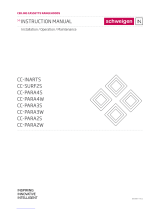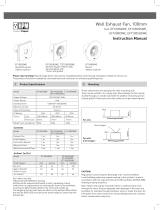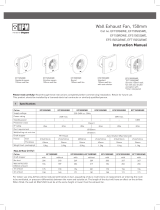
INSTALLATION GUIDE
BRW600
BRW622
www.schweigen.com.auRevision V4 06/12/21

Page 2
1. Welcome
Thank you for purchasing this Schweigen BRW600 system.
To get the maximum output from this unit, please read through this operating guide before use
and installation.
The operating guide contains important information on the correct use and maintenance of the unit,
as well as important safety notes. This will ensure your personal safety and the lasting value of your
motor system.
We trust that you will enjoy your new Schweigen BRW600 system.
Please always retain your proof of purchase to aid in any warranty queries.
This appliance and its packaging are produced by processes that minimise waste and respect
the environment.
Please help us to continue this eort to protect the environment by using the appliance eciently
and dispose of the packaging in a responsible manner.

Page 3
Table of Contents
1. Welcome _____________________________________________________________________________________ 2
2. Your Safety
Warning _______________________________________________________________________________________ 4
Before Installation ______________________________________________________________________________ 4
Electrical Cord __________________________________________________________________________________ 4
3. General
Motor Features ________________________________________________________________________________ 5
General Notes on Installation and Use ____________________________________________________________ 5
Recommended Installation Distance _____________________________________________________________ 5
Minimum Mounting Height ______________________________________________________________________ 6
Avoidance of Back Flow _________________________________________________________________________ 6
Safety of Children ______________________________________________________________________________ 6
Replacement of supply cord _____________________________________________________________________ 6
Why Flexi-duct _________________________________________________________________________________ 6
4. Roof Installation
1. Roof Installation _____________________________________________________________________________ 7
2. Eaves Installation ____________________________________________________________________________ 9
3. Wall Installation ______________________________________________________________________________ 10
Optional DVW600 Installation ________________________________________________________ 11
5. Back Draft Shutter System
Back Draft Shutter System Futment to Bell-mouth Adaptor ________________________________________ 12
6. Flexible Ducting
Flexible Ducting ________________________________________________________________________________ 13
Shallow Roof Space ____________________________________________________________________________ 14
7. Maintenance
Roof Restoration or Cleaning ____________________________________________________________________ 16
8. Measurements
Vent __________________________________________________________________________________________ 17
BRW600 Motor ________________________________________________________________________________ 18
9. Warranty / Disclaimer _______________________________________________________________________ 19

Page 4
2. Your Safety
1. This appliance is not intended for use by person/s (including children) with reduced physical, sensory
or mental capabilities, or lack of experience and/or knowledge. Unless the person has been given
supervision or instruction concerning the use of the appliance by a person responsible for their safety.
Children should be supervised to ensure that they do not play with the appliance, it is not a toy.
2. Air exhaust must be installed in accordance with local laws.
Before Installation
We recommend this appliance to be installed or repaired by a qualied Schweigen Home Appliances technician.
Please see our website www.schweigen.com.au for recommended installers.
It is dangerous to modify any part of this appliance. Modication of any kind, will immediately void the warranty.
The manufacturer declines all responsibility in case of failure to adopt proper safety measures.
Ensure that the location in which this appliance is installed, has good and permanent ventilation.
Please consult local laws and regulations and install in accordance.
Use an electrical connector with earth that is correct for your location.
Check that the voltage in your area corresponds to the appliance as indicated on the rating label.
Electrical Cord
Ensure the supply cord is not exposed to heat, chemicals or sharp objects. If the supply cord is damaged, it must be
replaced by the manufacturer, service agent or a similarly qualied person in order to avoid a hazard.
WARNING
Please read this section thoroughly before attempting to operate the appliance.
Inspect your product upon receipt. Any damage or defects MUST be reported
within 48 hours, or no claim will be recognised.
DO NOT INSTALL THIS APPLIANCE IF YOU FIND IT DAMAGED.
If this product is installed damaged, the supplier, nor the retailer, will be responsible
for the costs associated with the repair, replacement, removal or re-installation of
the appliances.

Page 5
3. General
This manual is for the installation of the motor systems use for bathroom and general extraction.
Motor Features
• Universal mounting all position with IPX4 degree of weather protection
• Patented anti water intrusion system.
• Acoustic dome with super quiet, long vane, backward curved centrifugal fan.
• Airow is dependant on installation and the ducting used.
• Using a single 150mm exi duct run you should attain 600m3/hr depending on the ducting installation.
• The use of a smaller 125 ducting would result in a loss of airow.
• Simple installation: - Mounts onto a 100mm PVC pipe for ultimate strength and allows for easy
Dektite roof sealing.
• Industrial quality motor and fan made in Germany and rated at 40,000 hours.
• Motor is a high eciency PSC type and rated at 62W.
• WARRANTY 5 YEARS return to manufacturer. Covers faulty manufacturing or components. It does not
cover normal wear and tear.
General Notes on Installation and Use
This fan unit is designed to be installed using 100mm PVC pipe as the initial connection duct to the fan module,
and is supplied with a 100mm PVC pipe to 150mm exible duct bell-mouth adaptor.
This fan is suitable for connection to multiple duct runs with a minimum inlet area of 11,000 mm². Ducting runs
should be more than 2 metres away from the unit and no more the 4-5 metres (check with supplier if longer
duct length required). Flexible ducting must be extended suciently to present a smooth air passage with
bends of at least the radii of twice the diameter of the duct.
WARNING: The BRW600 must not be ducted into a wall cavity or a ceiling space, where a build up of grease
can occur and become a potential re risk.
NOTE: Fan module and dual foil exi-duct are acoustically matched. The use of semi-rigid or rigid ducting will
result in increased noise levels and void the warranty. See installation instruction notes ‘Why exi-duct’.
Recommended Installation Distance
For the BRW600 motor system, a minimum of 2-3 metres is recommended.
NOTE: Installation closer than these distances will result in higher noise levels. Maximum duct length
4-5 metres. Check with supplier if longer length is required. Do not reduce the duct size at any time
and avoid sharp bends.

Page 6
3. General
Minimum Mounting Height
This fan unit is intended for mounting at a minimum height of 2.1 metres (measured to the lower part of the
fan impeller) above oor/ground level.
Avoidance of Back Flow
Care should be taken to avoid the back ow of gases into the room.
Safety of Children
This fan is not intended for use by young children or inrm persons without supervision.
Replacement of supply cord
If the supply cord is damaged, it must be replaced by a service agent or suitably qualied person in order
to avoid a hazard.
Why Flexi-duct
Some internet sites strongly recommend the use of rigid ducting over fully exible ducting.
The use of a complete rigid or semi-rigid ducting system will cause an organ piping eect to occur; like a
didgeridoo, where a noise is produced at one end of a hollow rigid pipe and the noise is amplied out the other.
The motor system puts the noise outside the house.
Warning: Installation without the use of at least the minimum recommended length of acoustically matched
exi-ducting will void performance expectations. Any installation problems must be reported to Schweigen.
Call outs relating to incorrect installation will result in a service fee direct to the customer. Schweigen takes
no responsibility for problems caused by faulty installation. Faulty installation may void warranty. A preferred
installer list can be obtained from the Schweigen website www.schweigen.com.au or call 1300 881 693.

Page 7
4. Installation
Roof Mount Option
Mounting Flange
110mm PVC Pipe
Dektite
Bell-mouth adaptor
Slot option
20
min
20
min
Eave Mount
Option
Wall Mount
Option
Bell-mouth adaptor
Min 90mm long PVC pipe
To fan
Vent
Electrical connection
between rangehood and
remote fan module
Figure 1 The three options for mounting the unit.
100 — 500
Ensure
clearance
Three options for mounting the unit
1. Roof Installation (Recommended duct length: 2-3 metre)
Mount the 100mm rigid PVC pipe securely to the beams, trusses or other appropriate structures, refer gure 1.
on the next page.
The pipe should be mounted either vertically or perpendicular to the roof cladding with the roof penetration
being sealed using a Dektite or other sealing device. Please note Schweigen do not provide any sealing kits.
Ensure that the pipe protrudes at least 80mm past the top of the Dektite, checking that the mounting ange
clears the roof cladding at upper edge as shown in gure 1.
The maximum recommended protrusion is 500mm. Fit mounting ange, refer gure 1, to pipe using silicon
sealant, then tape in position until sealant has set.
Fit fan module to the mounting ange by placing in position, rotating clockwise to engage bayonet ngers
and secure by screwing in locking screw (while holding fan module rmly in the fully clockwise position).
Please refer to page 12 (Figure 6)
for back draft shutter tment

Page 8
4. Installation
Figure 3
Locking Screw
Fan Module
Roof Clading
Mounting Flange
Dektite
Roof Frame
110mm PVC Pipe
Secure pipe to structure
150mm exible ducting
5 metre max
Power cord
Bell-mouth adaptor
Slot pipe for power cord
exit. Cover with ducting
tape if required
Optional
bend
Slot option
Please refer to page 12 (Figure 6)
for back draft shutter tment

Page 9
4. Installation
2. Eaves Installation
After ensuring sucient clearance exists for the mounting ange and ducting (gure 1), cut a circular hole
165mm Ø, maintaining adequate clearances. The eave sheeting must be reinforced.
Pre-drill mounting ange recess (gure 4).
If access to the eave space is restricted, before xing the mounting ange to the eave, preassemble the
mounting ange, PVC pipe, bell-mouth adaptor and exi-duct, then feed up into roof space. Remember to run
power cord through the assembly and out the slotted PVC pipe wall (gure 4).
Fit the fan module to mounting ange by placing in position, rotating clockwise to engage bayonet ngers then
secure by screwing in locking screw (while holding fan module rmly in the fully clockwise position).
Ensure that one of the three
bayonet ngers is accessible for
securing locking screw
Bell-mouth Adaptor
Roof Cladding
Locking Screw
Pre-drill mounting
ange recess and secure
to reinforced eaves
sheet using #8 self
tapping screws
Wall
Eaves
Top Plate
150mm Ducting
Roof Frame/Truss
Figure 4
Please refer to page 12 (Figure 6)
for back draft shutter tment

Page 10
4. Installation
3. Wall Installation
The installation should be similar to eaves mounting if access to the inside is limited, but if unrestricted.
Refer to EAVES INSTALLATION and gure 5.
Figure 5
Min 20mm
NOTE: Ensure that power cord is fed
through exit slot and is not allowed
to double back restricting fan inlet
Flexible 150mm ducting
Bell-mouth Adaptor
Min 90mm long PVC pipe
Please refer to page 12 (Figure 6)
for back draft shutter tment

Page 11
Hold diffuser
against board
and push upwards
To ggle clip snaps
into place holding
diffuser firmly
Operation of toggle clips
4. Installation
Figure 2 Ventilation Option for Dual Vent
BRW622 Duel Vent System or optional DVK600 Installation
To main
power/switch
Y-branch
Additional dual vent kit, Y-branch,
3 metre length exi ducting and
inlet grille (Kit model no: BRW622
or DVK600)
For bathroom installation, locate inlet
over shower recess
2m of ducting
2m of ducting
Reducer
Bell-mouth Adaptor
For dual installation, bathroom, toilet or laundry
Back Draft Stopper
• Do not reduce the ducting size. 150mm must be used. Reducing the ducting will reduce extraction
• No sharp bends in the ducting
• Do not kink the ducting
• keep the amount of bends in the ducting to 2 or 3
• Do not use semi-rigid or solid ducting
IMPORTANT

Page 12
5. Back Draft Shutter System
Vertical Installation
Figure 7 shows an example of vertical installation.
Back Draft Shutter System Fitment to Bell-mouth Adaptor
This back draft shutter system cannot be installed in eave type installation.
Figure 6
Figure 7
Back draft shutter system
Bell-mouth adaptor
Fit exi-duct over shutter assembly
Tape over anges
100mm pipe
to fan
Direction of
airow
To fan
IMPORANT
If shutter system
is mounted in the
horizontal position,
shutter shaft should
be vertical.
Part number: 150 MMBDSS
Back draft shutter system
Tape over anges
Air ow

Page 13
6. Flexible Ducting
Flexible Ducting
Flexible ducting must be fully extended and cut to the required length upon installation. Maximum fan
performance will not be achieved unless the ducting is fully extended. Failure to fully extend the ducting results
in smaller air passage and lower airow. Incorrect installation may reduce airow and increase noise levels. Call
outs relating to incorrect installation will result in a service fee directed to the customer. Schweigen will take no
responsibility for problems caused by faulty installation. Installation must be carried out by a qualied technician.
A preferred installer list can be obtained from Schweigen website www.schweigen.com.au.
Please do not crush or kink exible ducting as it will reduce
air ow and may cause noise to occur through the system.
Ducting must be kept taut at all times.
IMPORTANT
Please keep the exi ducting taut,
and 2-3 metres in length
NOTE: In shallow roof spaces
extend exi ducting horizontally
Reducer 200 to 150mm

Page 14
6. Flexible Ducting
Shallow Roof Space
In shallow roof spaces, 90 degree elbow PVC joint can be used as a substitute for the bend.

Page 15
Securing Flexible Duct
Flexible duct must be installed with supports at maximum intervals of 1.5 metres. Flexible ductwork can be
supported by using gaer or electrical tape, provided that it does not restrict the internal diameter of the
ducting. Ducting installed looped over hanging beams should be installed in such a manner as to ensure the
changes of direction are gradual. Support of the ducting with the use of hangers may be required, see option 2.
NOTE: Ducting should be kept taut at all times.
Figure 9 Examples of securing ducting
Option 1
Secure the exible duct
to the beam
Option 2
Support exible duct
by using hangers.
NOTE: Care shall be
taken to minimize
sagging or snaking
of the duct between
supports.
Aluminium foil
tape or cable tie
Aluminium foil tape or
cable tie
Hanger
6. Flexible Ducting

Page 16
7. Maintenance
Roof Restoration or Cleaning
Before roof restoration or cleaning, please completely cover the outside motor system and avoid
all chemical contact.
IMPORANT
Any damages caused by the
use of chemical products are
not covered by warranty.
Figure 10 Avoid chemical contacted to motor system

Page 17
Vent
8. Measurements
303
200
194.35
255
89
303
52.735.8
44.5
150mm reducer
255 x 255
Ceilling
Two timber support batons by installer
194.25mm outlet
240 x 240

Page 18
8. Measurements
157
278
35 minimum
370mm
BRW600 Motor
195
28
110
35
29
Please refer to page 12 (Figure 6)
for back draft shutter tment

Page 19
WARRANTY (See insert for more information)
Motor has a 5-Year replacement product warranty. This is a change over warranty. The consumer is responsible
for any charges associated with removal of the faulty unit and installation of the new unit. The customer is also
responsible for any freight charges incurred in the change over process.
Disclaimer
Under our policy of continuous product development, product specications may change without notice.
Prospective purchasers should therefore check with the retailer to ensure this publication correctly describes
the products being oered for sale. All information supplied is to be used for general reference purposes only
and is on the understanding that Schweigen Home Appliances will not be liable for any loss, liability or damage
of whatever kind arising as a result of any reliance upon such information. All pictures used in the guide are for
illustrative purposes only.
9. Warranty / Disclaimer
Calling the Technical Assistance Service Hotline
In the event that the failure is not due to the faults mentioned in Trouble Shooting,
contact Customer Service.
In Australia, Customer Service 1300 881 693
In New Zealand, Customer Service 0800 200 510
Lodging an online Service Request
In the event that failure is not due the reason/s in the trouble shooting section, you can lodge
an online Service Request.
To lodge a Service Request, visit our website www.schweigen.com.au/pages/support/service-warranty
and click on the link to download the service request form.
A service request will require the following information:
• The purchase date
• The rangehood model and motor type
• The rangehood serial number or batch number (this number is on a sticker inside the rangehood)
• A copy of the purchase receipt (without a receipt your service request cannot be processed)
Faulty Installation
It is not the responsibility of Schweigen Home Appliances to rectify any incorrect installations. A service call
out fee will be charged for any Schweigen technician that attends a call, whereby it is established that the
fault is due to an incorrect installation or non-manufacturing fault. Should the appliance be installed in such
a way that the service agent is unable to gain access to the appliance, the person/s who own the premises
where the appliance resides — will be responsible to provide access to the appliance at their expense.

Australia 4/1-5 Lake Drive, Dingley Village, Victoria 3172. Phone 1300 881 693
Email sales@schweigen.com.au Web www.schweigen.com.au
New Zealand 5 Tolich Place, Henderson, Auckland 0610. Phone 0800 200 510
Email info.par[email protected] Web www.parex.co.nz
SCH00015
-
 1
1
-
 2
2
-
 3
3
-
 4
4
-
 5
5
-
 6
6
-
 7
7
-
 8
8
-
 9
9
-
 10
10
-
 11
11
-
 12
12
-
 13
13
-
 14
14
-
 15
15
-
 16
16
-
 17
17
-
 18
18
-
 19
19
-
 20
20
Schweigen BRW600ST User manual
- Type
- User manual
Ask a question and I''ll find the answer in the document
Finding information in a document is now easier with AI
Related papers
-
Schweigen BRW622ST User guide
-
Schweigen BR550 User manual
-
Schweigen PKUM1390-6BST User manual
-
Schweigen UM1390-6SEL Owner's manual
-
Schweigen PKCC-PARA3SE User manual
-
Schweigen UM422G-12S Owner's manual
-
Schweigen Isodrive SP.1650 Owner's manual
-
Schweigen CL7275S User manual
-
Schweigen PKCC-PARA4WSP2 User guide
-
 Schweigen IN CC-PARA2S User manual
Schweigen IN CC-PARA2S User manual
Other documents
-
Sirius XS316 User manual
-
Falmec F3MLD90S1-EW1140 User manual
-
Whispair X7R09W5.IP User manual
-
Whispair X5R09W6.OU/B User manual
-
 HPM EFT100SQSWE Operating instructions
HPM EFT100SQSWE Operating instructions
-
Omega ORC916MB User manual
-
 Qasair TR CT FLANGE 1200 Operating instructions
Qasair TR CT FLANGE 1200 Operating instructions
-
Escea DX1000 Installation guide
-
 HPM EFS150SQSWE User manual
HPM EFS150SQSWE User manual
-
 HPM EFT150SQSWE Operating instructions
HPM EFT150SQSWE Operating instructions
























